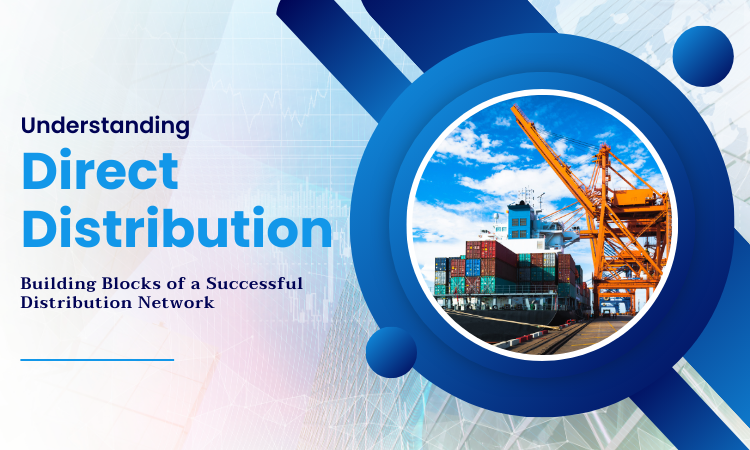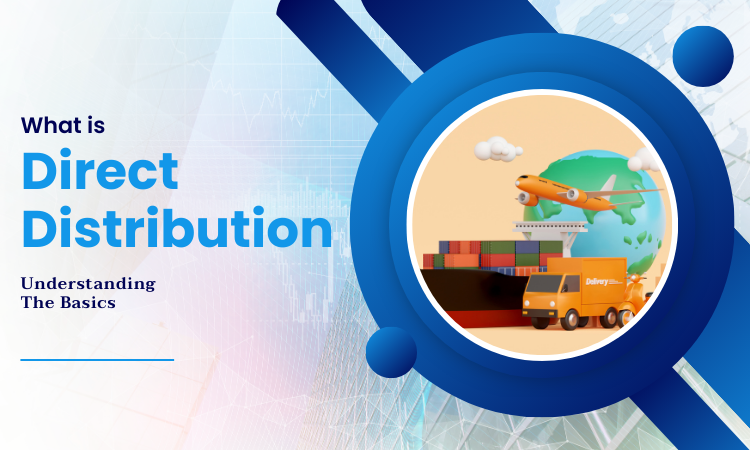Introduction
Building a successful distribution network is crucial for businesses looking to efficiently manage their supply chain and optimize their operations. In this blog post, we will explore the key components that make up a distribution network, including the concept of direct distribution. We’ll delve into the significance of supply chain distribution networks, network warehouse solutions, and the process of building a robust network distribution. Prepare to gain valuable insights into the building blocks of a distribution network to elevate your business logistics.

Unpacking Direct Distribution: What It Means for Your Supply Chain Network
In the world of logistics and supply chain management, the term “direct distribution” carries significant weight. It refers to a strategic approach that eliminates intermediaries, allowing manufacturers to ship their products directly to customers. This blog section will delve into what direct distribution entails and explore the impact it can have on your supply chain network.
Direct distribution offers businesses a more streamlined and efficient approach to delivering products. By bypassing traditional distribution channels and intermediaries, organizations can gain direct control over their entire supply chain process. This control not only increases efficiency but also provides greater flexibility in meeting customer demands.
One of the key advantages of direct distribution is the ability to cut out the middlemen and reduce costs. By eliminating distributors and wholesalers, manufacturers can pass on these cost savings to their customers, making their products more competitively priced in the market. Additionally, direct distribution offers better visibility and control over inventory, ensuring prompt delivery and minimizing inventory holding costs.
When implementing direct distribution, building a robust supply chain distribution network is crucial. This involves carefully selecting network warehouse solutions strategically located close to your target market. Choosing the right partners and suppliers will enhance your supply chain’s efficiency and reduce lead time, resulting in improved customer satisfaction.
Building a direct distribution network requires a thorough understanding of your customer base and their unique requirements. Analyzing customer preferences, order patterns, and delivery expectations will help determine the number and location of warehouses needed. This data-driven approach allows for the optimization of inventory levels and ensures quick order fulfillment, enhancing customer experience.

The Foundation of Success: Key Components of a Distribution Network
In the world of business, a well-designed distribution network is essential for success. It forms the backbone of any supply chain, ensuring products reach customers in a timely and efficient manner. One common approach to distribution is direct distribution. In this blog section, we will explore what direct distribution is, along with the key components involved in building a strong distribution network.
What is Direct Distribution?
Direct distribution refers to a method of delivering products directly from the manufacturer or producer to the end consumer. Unlike traditional distribution channels that involve intermediaries such as wholesalers and retailers, direct distribution eliminates middlemen, allowing companies to have greater control over the entire supply chain process. By cutting out intermediaries, businesses can reduce costs, maintain better quality control, and have a more direct relationship with customers.
Components of a Distribution Network:
A successful distribution network requires careful planning and strategic decision-making. Here are some key components to consider when building or optimizing your network distribution:
1. Warehouse In Distribution Network:
Effective storage and order fulfillment play a crucial role in a distribution network. Implementing network warehouse solutions such as strategically located warehouses and optimized inventory management systems can help expedite order processing and reduce delivery times.
2. Transportation Infrastructure:
Efficient transportation is vital in ensuring products are delivered promptly. Analyzing transportation routes, establishing relationships with reliable carriers, and utilizing technology-driven tracking systems can help streamline logistics, minimize costs, and improve overall customer satisfaction.
3. Embracing Technology and Automation In Distribution Network:
In today’s digital age, incorporating technology into supply chain operations is imperative. Embracing automation tools, advanced inventory management systems, and data analytics can enhance inventory visibility, drive accurate demand forecasting, and enable real-time tracking, improving efficiency at every stage.
4. Collaboration and Partnerships:
Building strong relationships with suppliers, manufacturers, and other key partners can lead to mutual benefits. Collaborating with reliable partners allows access to wider distribution channels, sharing of resources, and pooling expertise, enabling a more seamless and efficient distribution network.
The Importance of Direct Distribution in Optimizing Your Supply Chain Network
Direct distribution is a key concept in the realm of supply chain distribution networks. It refers to the process of delivering goods directly from the manufacturer to the end consumer, bypassing intermediaries. This type of distribution offers numerous benefits, including increased efficiency, reduced costs, and improved customer satisfaction. In this blog section, we will explore how warehouses solutions can play a crucial role in maximizing the efficiency of your distribution network.
One of the primary advantages of direct distribution is the elimination of unnecessary middlemen. By cutting out intermediaries, companies can streamline their supply chain, ensuring faster delivery times and minimizing the risk of miscommunication. This results in a more efficient distribution, as there are fewer touchpoints along the way.
To effectively implement direct distribution, a well-designed network of warehouses and fulfillment centers is essential. Warehouse solutions provide the infrastructure needed to store, organize, and distribute goods to different locations. By strategically locating warehouses in proximity to your target markets, you can significantly reduce shipping time and costs.
Utilizing technology and automation further optimizes the efficiency of warehouse solutions. Advanced inventory management systems allow for real-time tracking of stock levels, ensuring accurate forecasting and replenishment. Automated picking and packing processes minimize human error and streamline order fulfillment, leading to faster and more accurate deliveries.
Building a distribution network that incorporates warehouse solutions requires careful planning. Conducting thorough market research and analyzing customer demand patterns can help determine the optimal number and location of warehouses. Taking into account factors such as transportation infrastructure, labor availability, and regulatory requirements is vital to ensure smooth operations.

Building a Strong Distribution Network: Strategies and Best Practices
In today’s competitive business landscape, having a robust distribution network is crucial for companies looking to expand their reach ensure efficient product delivery. One of the key components of building a strong distribution network is understanding the concept of direct distribution.
What is Direct Distribution?
Direct distribution refers to the process of selling products directly to customers without involving intermediaries such as retailers or wholesalers. This approach allows companies to have greater control over their distribution process and enables them to establish a closer relationship with their customers.
Benefits of Direct Distribution:
1. Increased Profitability:
By cutting out intermediary fees, companies can improve their profit margins and generate better returns on their products.
2. Enhanced Customer Experience:
Direct distribution enables businesses to have direct communication with customers, leading to a better understanding of their needs and preferences. This, in turn, allows companies to tailor their products and services to meet customer demands effectively.
3. Greater Control:
With a direct distribution model, companies have more control over their brand messaging, pricing, and inventory management. This control ensures consistency across various sales channels, resulting in a seamless customer experience.
Building a Strong Distribution Network:
To build a strong distribution network, companies should consider the following strategies and best practices:
1. Define Your Distribution Network Strategy:
Start by determining your target market and the most effective channels to reach them. Consider factors such as customer demographics, market trends, and competitors’ distribution strategies.
2. Establish Relationships with Strategic Partners:
Collaborate with suppliers, manufacturers, and logistics providers who can contribute to the success of your network distribution. Build strong partnerships based on mutual trust and alignment of goals.
3. Invest in Distribution Network Warehouse Solutions:
Implement efficient warehousing and distribution center solutions to ensure timely delivery and minimize shipping costs. Utilize inventory management systems to optimize stock levels and reduce the risk of stockouts or overstocks.
4. Leverage Technology In Distribution Network:
Embrace technology solutions such as e-commerce platforms, order management systems, and analytics tools to streamline your distribution processes and gain insights into customer behaviors.
5. Continuous Performance Monitoring Of Distribution Network:
Regularly assess the key performance indicators (KPIs) of your distribution network, such as on-time delivery rates, customer satisfaction, and cost efficiency. Identify areas for improvement and make necessary adjustments to enhance the overall performance.
Understanding Direct Distribution: A Guide to Streamlining Your Supply Chain
Building an efficient supply chain distribution network is essential for businesses to maintain a competitive edge in today’s fast-paced market. One of the key strategies in optimizing your supply chain is direct distribution. In this blog, we will explore what direct distribution is and how it can streamline your supply chain, along with network warehouse solutions to consider.
Advantages of Direct Distribution:
1. Cost Efficiency:
By eliminating middlemen, businesses can eliminate the costs associated with warehousing, handling, and transportation that would otherwise be required.
2. Faster Delivery:
Direct distribution allows businesses to ship products directly to customers, reducing transit times and ensuring timely delivery.
3. Improved Customer Experience:
With direct distribution, businesses have complete control over the fulfillment process, ensuring that customers receive their orders accurately and in a timely manner.
Distribution Network Warehouse Solutions:
To effectively implement direct distribution, it is crucial to establish a strong network warehouse solution. Here are a few key considerations:
1. Strategic Location:
Choose warehouse locations strategically to minimize transportation costs and optimize delivery times.
2. Technology Integration:
Implement warehouse management systems that utilize advanced technologies such as automation, robotics, and real-time inventory tracking to streamline operations.
3. Scalability:
Consider the future growth of your business and choose warehouse solutions that can accommodate increasing demand.
Streamlining Your Supply Chain:
Direct distribution plays a vital role in streamlining your supply chain. It allows you to cut down on unnecessary costs, reduce delivery times, and provide a superior customer experience. By optimizing your network warehouse solutions, you can further enhance the efficiency and effectiveness of your direct distribution strategy.

Understanding Direct Distribution: Building Blocks of a Successful Distribution Network
In the dynamic world of supply chain management, direct distribution plays a crucial role in the success of any business. It encompasses the process of delivering goods directly from the manufacturer to the end customer, bypassing intermediaries such as wholesalers or retailers. This article explores the core components of a successful distribution network and sheds light on the importance of building an efficient direct distribution system.
1. Supply Chain Distribution Network:
A supply chain distribution network is a crucial part of any distribution strategy. It refers to the interconnected set of systems and resources involved in the procurement, production, storage, and transportation of goods. The efficiency and effectiveness of this network determine how well a company can deliver products to consumers in a timely manner, ensuring customer satisfaction and recurring business.
2. Network Warehouse Solutions:
One of the key building blocks of a successful distribution network is the careful selection and utilization of warehouse solutions. Efficient warehouse management ensures that the right products are in the right place at the right time. By optimizing inventory levels, minimizing storage costs, and implementing cutting-edge technology such as automated picking systems, businesses can increase their speed of order fulfillment and reduce operational costs.
3. Optimized Transportation:
Transportation is the lifeline of any distribution network. To achieve direct distribution, businesses need to design efficient transportation routes and modes that minimize transit times and reduce costs. Utilizing advanced routing and tracking technologies, businesses can streamline their delivery processes, track shipments in real-time, and provide accurate delivery estimates to customers.
4. Effective Inventory Management:
An effective distribution relies on streamlined inventory management. Businesses must forecast demand accurately, maintain optimal stock levels, and have a clear understanding of their inventory turnover rates. By implementing inventory management best practices, such as just-in-time (JIT) inventory systems and real-time inventory tracking, companies can ensure they have the right amount of stock to meet customer demands without excess inventory or stockouts.
5. Scalability and Flexibility In Distribution Network:
Building a successful distribution network requires foresight and the ability to adapt to changing market conditions. As businesses grow, their distribution needs evolve. Having a scalable and flexible network allows companies to expand their operations smoothly and adjust their distribution strategies to meet increasing customer demand or changes in the market.

Warehouse Solutions: Enhancing Productivity in Your Distribution Network
In the realm of supply chain distribution networks, building an efficient and effective system is vital for the success of any business. One key aspect of this system is direct distribution, which can significantly enhance productivity. In this blog, we will explore what direct distribution is and how network warehouse solutions can optimize your distribution network.
Benefits of Direct Distribution in Supply Chain Networks:
1. Improved Efficiency:
By cutting out intermediaries, direct distribution streamlines the supply chain process, reducing unnecessary handling of products. This results in faster order processing, increased speed-to-market, and ultimately, customer satisfaction.
2. Cost Savings:
Direct distribution eliminates the markups associated with intermediaries, allowing businesses to offer competitive pricing to customers. Additionally, by minimizing shipping and storage costs, companies can optimize their logistics expenses and operate more efficiently.
Network Warehouse Solutions for Enhanced Productivity
1. Warehouse Automation:
Implementing advanced technologies such as automated storage and retrieval systems (AS/RS), pick-to-light systems, and conveyor systems can significantly enhance productivity in your distribution. These solutions help streamline order fulfillment processes, minimize errors, and maximize throughput.
2. Inventory Management Systems:
Utilizing state-of-the-art inventory management systems can improve real-time visibility, optimize order fulfillment, and reduce stock-outs. By integrating these systems with your network warehouse, you can efficiently manage inventory levels, identify slow-moving products, and make data-driven decisions to improve overall operational efficiency.

Understanding the Basics: What is Direct Distribution?
Direct distribution is a supply chain distribution network strategy that allows businesses to deliver their products directly to customers without the involvement of intermediaries such as wholesalers or retailers. This means that the company takes full control of the distribution process, from warehousing to final delivery.
Direct distribution offers several advantages for businesses. Firstly, it allows for better control over the distribution process, ensuring that products reach the customers in a timely and efficient manner. Secondly, it eliminates the need for intermediaries, which can lead to cost savings and greater profitability. Lastly, direct distribution enables businesses to establish a closer relationship with their customers, as they have direct access to their feedback and preferences.
Building a successful direct distribution network requires careful planning and consideration. One of the key elements to consider is the location of your network warehouse. Ideally, the warehouse should be strategically located to minimize transportation costs and optimize delivery times. It should also be equipped with the necessary technology and infrastructure to efficiently manage inventory and fulfill orders.
When mapping out your distribution network, it is crucial to consider your target market and its geographical spread. This will help you determine the number and location of additional warehouses or fulfillment centers needed to ensure timely deliveries across different regions. Additionally, you should assess the logistical challenges associated with each region, such as transportation infrastructure and customs regulations, and factor them into your network planning.
To further optimize your direct distribution network, consider partnering with third-party logistics providers (3PLs) who specialize in network warehouse solutions. These providers have the expertise and resources to handle the complex logistics involved in managing multiple distribution centers and coordinating deliveries.
The Role of Direct Distribution in Supply Chain Optimization
In supply chain management, direct distribution optimizes distribution network efficiency and efficacy. How is direct distribution necessary for a successful supply chain distribution network? Explore this topic and unleash direct distribution’s power.
Direct distribution is delivering things directly from the maker or producer to the consumer without intermediaries. It eliminates wholesalers, merchants, and other intermediaries to deliver products directly to customers.
Direct distribution offers many advantages to companies. Cost savings are a major benefit. Eliminating middlemen eliminates markup fees and inventory holding costs. Cost savings can be passed on to consumers as lower costs, making products more competitive.
Direct distribution improves supply chain control. Direct distribution allows organizations to constantly monitor inventory levels, delivery schedules, and consumer feedback to make educated decisions and respond quickly to market demands. This control boosts efficiency and consumer happiness.
Companies must consider geographic coverage, transportation options, and warehouse solutions when building a distribution network. A network warehouse system strategically positioned across regions ensures faster and cheaper delivery. Inventory management software improves storage capacity and order fulfillment.
Direct distribution also lets companies interact directly with customers. Direct interaction improves customer service, brand loyalty, and personalization. Companies can use customer data to understand consumer behavior and preferences to improve product development and business strategy.
Optimizing Your Supply Chain Distribution Network for Success
In today’s fast-paced business environment, having an efficient and effective distribution network is crucial for companies looking to stay competitive. From startups to multinational corporations, organizations must carefully design and manage their supply chain distribution networks to ensure smooth operations and maximize customer satisfaction.
One of the fundamental aspects of a distribution network is the concept of direct distribution. So, what exactly is direct distribution? In a direct distribution model, companies bypass intermediaries such as retailers or wholesalers and directly deliver products to the end consumer. This approach offers several advantages, including cost savings, increased control over the delivery process, and more direct communication with customers. By eliminating the middleman, companies can streamline their operations and reduce lead times, resulting in a faster and more efficient delivery process.
However, building a successful distribution network goes beyond just implementing direct distribution. It requires meticulous planning, strategic partnerships, and utilizing network warehouse solutions. A well-designed distribution network ensures that products are in the right place at the right time, with minimal handling and optimal inventory levels.
When it comes to network warehouse solutions, companies have a plethora of options to consider. Utilizing modern technologies such as automated storage and retrieval systems, conveyor systems, and robotics can significantly enhance warehouse efficiency. These solutions not only improve order accuracy and speed but also reduce labor costs and minimize potential errors. Additionally, implementing advanced inventory management systems and employing data-driven analytics can provide valuable insights to optimize supply chain operations.
The ultimate goal of a successful distribution network is to create a seamless flow of goods, from the manufacturing facility to the end consumer. By establishing strategic partnerships with reliable transportation providers, companies can ensure timely and cost-effective deliveries. Leveraging technology for real-time tracking and visibility further enhances the overall efficiency of distribution process.
Conclusion
Understanding the key components of a distribution network is crucial for businesses looking to optimize their supply chain distribution network. Direct distribution plays a significant role, helping companies save costs and improve efficiency. By implementing network warehouse solutions and carefully building a distribution network, businesses can ensure seamless operations and enhanced customer satisfaction. Stay ahead of the competition by mastering these building blocks and harnessing the power of a well-designed distribution network.
